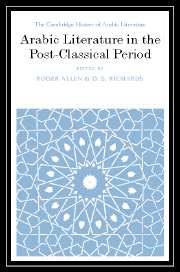17 - Drama in the post-classical period: a survey
from Part V - Drama
Published online by Cambridge University Press: 28 March 2008
Summary
In this chapter on the evolution of Arab drama in the post-classical period, attention will be paid to imitation and to recitation: both forms had been widespread in the Arab world ever since the remotest of times and were still extremely active in the era in question. Particular attention will be paid to connections and mutual influence of a formal type which linked certain kinds of literature of popular origin, initially oral and only later in written form, to literary texts in lofty style intended for public recitation. At the same time an attempt will be made to highlight the common desire to imitate reality, present in many forms of Arab literature from the ninth century onwards, in both popular farces and literary works not necessarily destined for the stage. In addition to the analysis of these artistic aspects, which may be defined as collateral in comparison to true drama, texts which were created directly for the theatre between the thirteenth and the early nineteenth century will also be examined.
Despite the immense time-span covered by this historical period, we need to extend the chronological limits imposed by the term ‘post-classical’ even further, in order to be able to consider the dramatic spirit of the era in question in relation to both its antecedents in the classical period to whose literary forms it was strictly tied, and developments at the out set of the modern era. This latter period saw the awakening to new stimuli (coinciding with both the political and literary Nahda) and not only led to countless significant consequences in Arab production (which also brought about changes and innovations in the actual theatre), but also coincided with a renewed desire to recover the traditions and artistic forms of the past.
- Type
- Chapter
- Information
- Arabic Literature in the Post-Classical Period , pp. 345 - 368Publisher: Cambridge University PressPrint publication year: 2006



